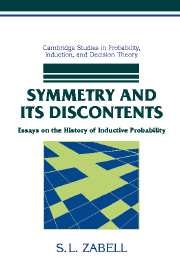3 - Buffon, Price, and Laplace: Scientific Attribution in the 18th Century
Published online by Cambridge University Press: 05 June 2012
Summary
INTRODUCTION
Laplace's rule of succession states, in brief, that the probability of an event recurring, given that it has already occurred n times in succession, is (n + 1)/ (n + 2). In his Essai philosophique sur les probabilités (1814), Laplace gave a famous, if notorious illustration of the rule: the probability of the sun's rising.
Thus we find that an event having occurred successively any number of times, the probability that it will happen again the next time is equal to this number increased by unity divided by the same number, increased by two units. Placing the most ancient epoch of history at five thousand years ago, or at 1826213 days, and the sun having risen constantly in the interval at each revolution of twenty-four hours, it is a bet of 1826214 to one that it will rise again to-morrow.
[Laplace, Essai philosophique, p. xvii]This passage was at the center of a spirited debate for over a century about the ability of the calculus of probabilities to provide a satisfactory account of inductive inference (e.g., Keynes 1921, Chapter 30). Although the later history of this debate is well known, what is less well known, perhaps, is its history prior to the appearance of Laplace's Essai. In fact, the question whether belief in the future rising of the sun can be expressed probabilistically had been briefly alluded to by Hume in his Treatise of 1739, and had been discussed prior to the appearance of Laplace's Essai by Price, Buffon, Condorcet, Waring, Prevost, and L'Huilier (e.g., Zabell, 1988, Section 5).
- Type
- Chapter
- Information
- Symmetry and its DiscontentsEssays on the History of Inductive Probability, pp. 74 - 83Publisher: Cambridge University PressPrint publication year: 2005



